You are using an out of date browser. It may not display this or other websites correctly.
You should upgrade or use an alternative browser.
You should upgrade or use an alternative browser.
Massive San Francisco Fire
- Thread starter TXgolfer
- Start date
- Joined
- Jul 26, 2009
- Messages
- 19,035
- Reaction score
- 8
We knew that last night.
I took it as pipelines in general. Oil pipeline, gas pipeline ect..
Maybe someone took a giant dump and contained too much methane?
All jokes aside, the fact it happened under PG&E and -apparently- residents smelled the gas for days (anyone report it to PG&E???). That was a big explosion.
- Joined
- Jul 26, 2009
- Messages
- 19,035
- Reaction score
- 8
facepalm
If it was leaking to the point where you could smell it....
A) It would be making an extremely loud whistle.....even underground
B) It wouldn't explode.....might create a giant flame....but no explosion. Movies are fake.
Gas doesn't go backwards....especially in high pressure lines. Most contractors....whether they admit it or not.... test for gas leaks with a match. I did for 10 years before I bought a sniffer.....still did it some after that
If it was leaking to the point where you could smell it....
A) It would be making an extremely loud whistle.....even underground
B) It wouldn't explode.....might create a giant flame....but no explosion. Movies are fake.
Gas doesn't go backwards....especially in high pressure lines. Most contractors....whether they admit it or not.... test for gas leaks with a match. I did for 10 years before I bought a sniffer.....still did it some after that
facepalm
If it was leaking to the point where you could smell it....
A) It would be making an extremely loud whistle.....even underground
B) It wouldn't explode.....might create a giant flame....but no explosion. Movies are fake.
Gas doesn't go backwards....especially in high pressure lines. Most contractors....whether they admit it or not.... test for gas leaks with a match. I did for 10 years before I bought a sniffer.....still did it some after that
I deserve the facepalm...I really don't know much about gasses(even if it's some more common sense stuff).. yeah...if it smells a certain way, I'd be concerned but I don't know if I'd report it?
hmmm...so it was - a natural gas "explosion"? I'm confused.
- Joined
- Jul 26, 2009
- Messages
- 19,035
- Reaction score
- 8
I deserve the facepalm...I really don't know much about gasses(even if it's some more common sense stuff).. yeah...if it smells a certain way, I'd be concerned but I don't know if I'd report it?
hmmm...so it was - a natural gas "explosion"? I'm confused.
Most likely it was at a main or junction and when the fracture in the pipe occured a spark was also created. Usually it happens when a worker accidently strikes a line. Dunno what caused this one.......
- Joined
- Apr 27, 2007
- Messages
- 69,284
- Reaction score
- 143
is it "unusual" or low-chance to have a big as incident as this incident was?
no
- Joined
- Jul 26, 2009
- Messages
- 19,035
- Reaction score
- 8
No
http://en.wikipedia.org/wiki/List_of_pipeline_accidents
This just happened in a crowded area this time
http://en.wikipedia.org/wiki/List_of_pipeline_accidents
United States
1965: Gas transmission pipeline, north of Natchitoches, Louisiana, belonging to the Tennessee Gas Pipeline Company explodes from stress corrosion cracking, killing 17 people. This accident lead to then President Lyndon B. Johnson to call for the formation of a national pipeline safety agency. (March 4, 1965)
1968: Ruptured LPG pipeline, near Yutan, Nebraska. Repair crews responded to a pipeline rupture, thought vapors were dispersed, but ignited a vapor cloud by driving into it. Five repairmen were killed. (December 5, 1968)
1969: Low pressure natural gas distribution system, Gary, Indiana. (June 3, 1969)
1969: High pressure natural gas pipeline. A 14-inch (360 mm) natural gas pipeline running at 789 psi near Houston, Texas ruptures, causing a massive fire. Construction work downstream of the accident lead to a pressure build up that caused the rupture. September 9, 1969.
1970: Colonial Pipeline Company, petroleum products pipeline, Jacksonville, Maryland, (September 3, 1970.
1970: 1970 Propane vapour cloud explosion in Port Hudson, Phillips Pipeline Company propane gas explosion, Franklin County, Missouri. Leak lead to propane cloud explosion with a force of several tons of TNT. (December 9, 1970)
1970: Explosion of a 30 inch diameter 1100 psi inlet natural gas pipeline, bringing offshore natural gas into a gas drying plant in southern Louisiana. Two plant personnel were killed. Rupture was at a junction of a 12 inch gas line to the 30 inch main line. (December 1970)
1972: Rupture of propane pipeline, near Butler, Alabama. A road grader in use hit a high pressure propane pipeline. A short time after the line was ruptured, a car drove into the vapor cloud, igniting it, and killing four people. (June 20, 1972)
1973: Natural gas liquids pipeline rupture. Austin, Texas A natural gas liquids (NGL) pipeline ruptured due to an improper weld. Six people killed. (February 22, 1973)
1975: Natural gas liquids pipeline rupture. An NGL pipeline ruptured due to previous mechanical damage at Devers, Texas. 4 killed in vapor cloud fire. (May 12, 1975)
1975: LPG pipeline rupture. An LPG pipeline ruptured near Romulus, Michigan, due to previous mechanical damage to the pipeline and over pressurization from operator error at a storage facility. Nine people were injured in the vapor cloud fire. (August 2, 1975)
1976 LPG pipeline rupture. An LPG pipeline ruptured near Whitharral, Texas, leading to vapor cloud fire that killed five and destroyed two homes. Electrical resistance weld (ERW) failure is suspected for the failure. (February 25, 1976)
1976 Petroleum products pipeline. A front loader hit an eight inch petroleum products pipeline in Los Angeles, California during a road widening project along Venice Boulevard. 9 were killed, and serious property damage occurred.(June 16, 1976)
1976 Natural gas pipeline rupture. A road grader hit a 20-inch (510 mm) gas transmission pipeline near Cartwright, Louisiana. Six killed in the following fire. (August 9, 1976)
1977 LPG pipeline rupture. A LPG pipeline ruptured near Ruff Creek, Pennsylvania from stress corrosion cracking. The resulting propane vapor cloud ignited when a truck driven into the cloud stalled, then created a spark when it was restarted. (July 20, 1977)
1978 LPG pipeline rupture and fire. An LPG pipeline at Donnellson, Iowa ruptured from past mechanical damage and improper lowering for road improvements. The vapor cloud ignited several minutes after the rupture. Three people were killed. (August 4, 1978)
1978 A gas pipeline in Brookside Village, Texas ruptured and exploded, killing five people, and injuring 43 others. Seven mobile homes were also destroyed, (October 24, 1978)
1979 Natural gas pipeline rupture. An anchor handling boat, PETE TIDE II, damages an unmarked gas pipeline with a grappling hook offshore from New Orleans, Louisiana. A fire followed, and the two of the crew were missing and presumed dead. (July 15, 1979)
1980 A pipeline carrying naptha ruptured under a street in Long Beach, California, causing a fire that destroyed one home and damaged several others. Two people were injured. Lack of communication of pipeline valve setups, and pressure relief valves set to open at too high a pressure were identified by the NTSB as causes of the accident. (December 1, 1980)
1981 A 12-inch-diameter (300 mm) pipeline near Ackerly, TX, was hit by a rathole drill, releasing an ethane-propane mix. There was then an explosion & fire that killed 4 people. (September 27, 1981)
1983 An 8-inch (200 mm) LPG pipeline was hit by a rotating auger used for planting trees near West Odessa, TX. After several minutes, the escaping LPG ignited, killing 5 people & injuring 5 others. (March 15, 1983)
1984 An 8-inch (200 mm) NGL pipeline near Hurst, TX, was hit by a front loader, and the escaping gases ignited, causing burns to the equipment operator. (February 28, 1984)
1985 A 30-inch-diameter (760 mm) gas pipeline weakened by atmospheric corrosion ruptured near Beaumont, KY. 5 people were killed, and 3 injured. (April 27, 1985)
1986 A 30-inch-diameter (760 mm) gas pipeline ruptures due to corrosion near Lancaster, KY. 3 people had serious burns, and 5 others had lesser injuries. (February 21, 1986)
1986 A backhoe snags a gas distribution line in Fort Worth, TX, causing a break that leaked gas into a unoccupied building. Later, that building exploded, injuring 22 people, destroying the unoccupied building, & damaging 40 other buildings. 57 automobiles in the unoccupied building were damaged or destroyed. (March 12, 1986)
1986 Petroleum products pipeline rupture at Mounds View, Minnesota. Gasoline at 1,434 psi sprayed a residential area around 4:20 am local time, then ignited. Two were killed, and many homes damaged or destroyed. Confusion by the pipeline company lead to a delay in shutting down the pipeline. Electrical resistance welded (ERW) seam failure caused the rupture. (July 8, 1986)
1989 Petroleum products pipeline failure after the San Bernardino train disaster, California. Damage from derailment cleanup caused petroleum products pipelines to rupture, spraying homes with gasoline. Three killed in following fire.
1989 New York City Con Edison Steam Pipe explosion, rupture 3 are killed in the 3rd ave- Grammercy Park area.
1990 Propane pipeline rupture and fire, North Blenheim, New York, March 13, 1990. Stress from previous work done on a pipeline causes rupture, vapor cloud moved downhill into a town. 2 killed and numerous buildings destroyed when the cloud ignited.
1993 On Sunday, March 28 at 8:48, a pressurized 36-inch-diameter (910 mm) petroleum product pipeline owned and operated by Colonial Pipeline Company ruptured near Hemdon, Virginia. The rupture created a geyser which sprayed diesel fuel over 75 feet into the air, coating overhead powerlines and adjacent trees, and misting adjacent Virginia Electric Power Company buildings. The diesel fuel spewed from the rupture into an adjacent storm water management pond and flowed overland and through a network of storm sewer pipes before reaching Sugarland Run Creek, a tributary of the Potomac River.[4]
1994 Texas Eastern Transmission Corporation Natural Gas Pipeline Explosion and Fire Previous damage cause a natural gas transmission pipeline to rupture at Edison, New Jersey on March 23, 1994.
1996 Butane Pipeline rupture and fire, near Lively, Texas, August 24, 1996. 2 killed after driving into an unseen butane cloud. Leak was caused by external corrosion.
1997 Pipeline Rupture and Fire, Indianapolis, Indiana, July 21, 1997.
1998 Natural Gas Explosion and Fire, South Riding, Virginia, July 7, 1998.
1998 Natural Gas Pipeline Rupture and Subsequent Explosion, St. Cloud, Minnesota, December 11, 1998.
1999 Natural Gas Explosion and Fire at a gas pressure station, Wytheville, Virginia, destroying a home and motorcycle store.[5] (January 3, 1999)
1999 Natural Gas Service Line and Rupture and Subsequent Explosion and Fire, Bridgeport, Alabama, January 22, 1999
1999 A pipeline in a Bellingham, Washington park leaked gasoline, vapor from the leak exploded and killed 2 10 year old boys and an 18 year old man on June 10, 1999. Issues causing the rupture were found to be previous pipe damage by excavation, incorrectly set up pressure relief valve, unexpected remote valve closure, and new software tests on the live controlling computer.
2000 Hazardous Liquid Pipe Failure and Leak, Explorer Pipeline Company, Greenville, Texas, March 9, 2000.
2000 Natural Gas Pipeline Rupture and Fire Near Carlsbad, New Mexico This Explosion Killed 12 Members Of The Same Family. Cause was due to severe internal corrosion of the pipeline. (August 19, 2000)
2000 Rupture of Piney Point Oil Pipeline and Release of Fuel Oil Near Chalk Point, Maryland, April 7, 2000.
2002 Rupture of Enbridge Pipeline and Release of Crude Oil near Cohasset, Minnesota, On July 4, 2002 an Enbridge pipeline ruptured in a marsh near Cohasset, in Itasca County, spilling 6,000 barrels (~250,000 gallons) of crude oil. In an attempt to keep the oil from contaminating the Mississippi River, the Minnesota Department of Natural Resources set a controlled burn that lasted for 1 day and created a smoke plume about 1 mile high and 5 miles long.[6]
2003 Excavation Damage to Natural Gas Distribution Line Resulting in Explosion and Fire, Wilmington, Delaware, July 2, 2003.
2004 On November 21, 2004, a 14-inch-diameter (360 mm) petroleum multiproduct pipeline sprung a leak that was transporting gasoline at the time of the release. The pipeline, owned and operated by the California-Nevada Pipeline Company, a subsidiary of Kinder-Morgan Energy Partners, is the main source of petroleum fuel products for Las Vegas, NV. An 80 foot geyser was discovered on the morning of November 22, 2004, after numerous complaints of a strong gasoline odor on Interstate 15 in northern San Bernardino County, CA.[7]
2007 On January 1, an Enbridge pipeline that runs from Superior, Wisconsin to near Whitewater, Wisconsin failed, resulting in a spill of ~50,000 gallons of crude oil onto farmland and into a drainage ditch.[8] The same pipeline was struck by construction crews on February 2, 2007, in Rusk County, Wisconsin, spilling ~126,000 gallons of crude. Some of the oil filled a hole more than 20 feet deep and was reported to have contaminated the local water table.[9]
2007 2007 New York City steam explosion, on July 18, 2007
2007 A 12-inch (300 mm) propane pipeline explodes, killing two and injuring five others near Carmichael, AL on November 1, 2007. The NTSB determined the probable cause was likely ERW seam failure. Inadequate education of residents near the pipeline about how to respond to a pipeline accident was also cited as a factor in the deaths.
2008 Natural gas pipeline explodes and catches fire on February 5, near Hartsville, TN Believed to have been caused by a tornado hitting the facility.
2008 A gasoline release from a petroleum pipeline occurred on November 25, 2008 at a retail mall in Murrysville, PA. Officials said the release occurred from the six-inch line at about 9:30 a.m. while a Sunoco Logistics crew was working on a ball valve.[10]
2009 A rupture of pipeline near Cygnet, Ohio, owned by Philadelphia-based Sunoco Logistics Partners LP, resulted in one of the largest oil spills in Wood County history. Feb. 18, 2009.[11]
2009 Natural gas pipeline explodes and catches fire on May 5, 2009 near Rockville, IN in Parke County about 24 miles north of Terre haute, IN. PHMSA indicated the possibility of external corrosion in its Corrective Action Order (CAO) to the pipeline company. Pictures have been released around the area showing the damage caused. 49 homes were evacuated in a one-mile area of the explosion. No injuries reported.
2009 Bushland, Texas — Two people hurt when a natural gas pipeline exploded in the Texas Panhandle. The explosion early Thursday 5 November left a hole about 30 yards by 20 yards and close to 15 feet deep. The blast shook homes, melted window blinds and shot flames hundreds of feet into the air. The home nearest the blast — about 100 yards away- was destroyed. Bushland is about 15 miles west of Amarillo.[12]
2009 A new 42-inch (1,100 mm) gas transmission pipeline near Philo, Ohio fails on the second day of operation. There was no fire, but evacuations resulted. (November 14, 2009)
2010 On Monday, July 26, the pipeline company, Enbridge Energy Partners LLP (Enbridge), reported that a 30-inch (760 mm) pipeline belonging to Enbridge burst in Marshall, Michigan. The company estimates over 800,000 gallons of crude oil leaked into Talmadge Creek, a waterway that feeds the Kalamazoo River.[13] [14] [15]
2010 On Thursday, September 9, a high pressure gas pipeline exploded in San Bruno, CA. It destroyed 38 homes and damaged 120 homes. Four people died and many were injured. 10 acres burned in total.[16] [17]
This just happened in a crowded area this time
- Joined
- Apr 27, 2007
- Messages
- 69,284
- Reaction score
- 143
facepalm
If it was leaking to the point where you could smell it....
A) It would be making an extremely loud whistle.....even underground
B) It wouldn't explode.....might create a giant flame....but no explosion. Movies are fake.
Gas doesn't go backwards....especially in high pressure lines. Most contractors....whether they admit it or not.... test for gas leaks with a match. I did for 10 years before I bought a sniffer.....still did it some after that
The Third World country used the old method for sniffer test - the bird cage with sparrows.
Since the people reported smelling gas odor coming from gutter and sewer.... it's probably why there was an explosion. The underground chambers filled with gas. ka boom!
- Joined
- Jul 26, 2009
- Messages
- 19,035
- Reaction score
- 8
This tough old bird is a distant relative. It says front door but was actually front window. What hapened in this case is she had a gas oven installed the day before but the guy didn't pressure test the line after turning the main back on. Too much gas built up and the gas blew the oxygen away from the pilot. there was too much pressure so the regulator was overwhelmed and the oven filled with gas.....then the pilot automatically tried to relight......BOOM! She should have called me to do the install instead. *shrug*
Saturday, September 11, 2010 / LJWorld.com
Saturday, September 11, 2010 / LJWorld.com
- Joined
- Jul 26, 2009
- Messages
- 19,035
- Reaction score
- 8
The Third World country used the old method for sniffer test - the bird cage with sparrows.
Since the people reported smelling gas odor coming from gutter and sewer.... it's probably why there was an explosion. The underground chambers filled with gas. ka boom!
My guess is that they smelled sewer gas which would occur with the ground shifting......which could also lead to a pipe fracture. I still go back to if there was a leak in a high pressure line they would hear it.
I
 I could be wrong but I don't think so
I could be wrong but I don't think so- Joined
- Apr 27, 2007
- Messages
- 69,284
- Reaction score
- 143
This tough old bird is a distant relative. It says front door but was actually front window. What hapened in this case is she had a gas oven installed the day before but the guy didn't pressure test the line after turning the main back on. Too much gas built up and the gas blew the oxygen away from the pilot. there was too much pressure so the regulator was overwhelmed and the oven filled with gas.....then the pilot automatically tried to relight......BOOM! She should have called me to do the install instead. *shrug*
Saturday, September 11, 2010 / LJWorld.com

- Joined
- Jul 26, 2009
- Messages
- 19,035
- Reaction score
- 8
freckles
New Member
- Joined
- Apr 26, 2008
- Messages
- 2,011
- Reaction score
- 0
said, here and few pictures I took today.. all I saw were just chimneys, vehicles down on ground and even just heat of flame melted vehicles.
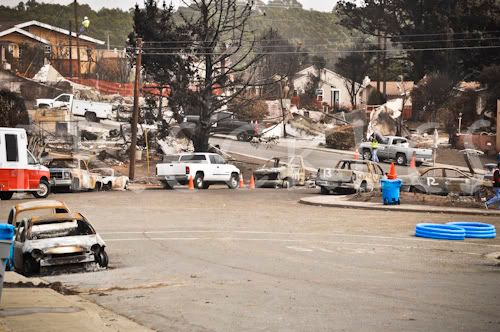
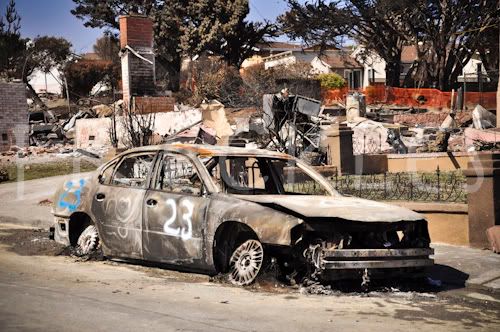
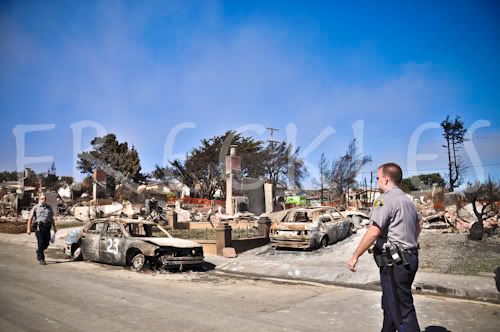

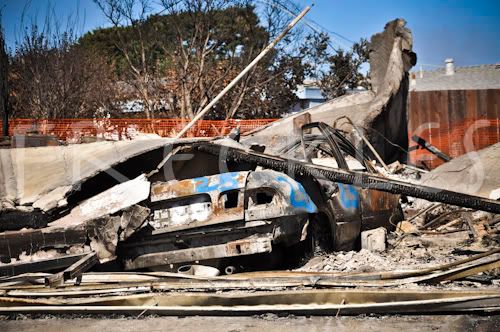
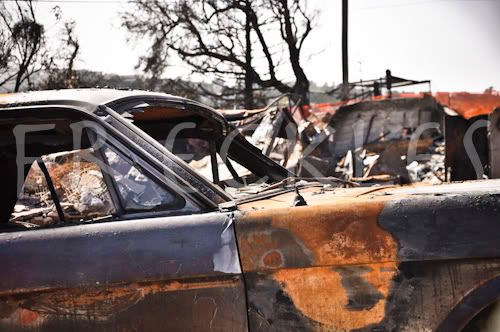
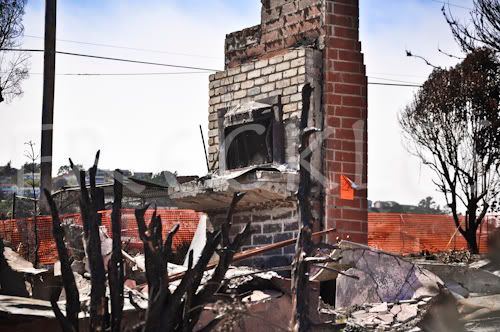
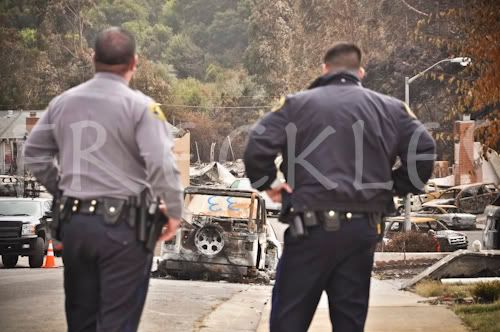

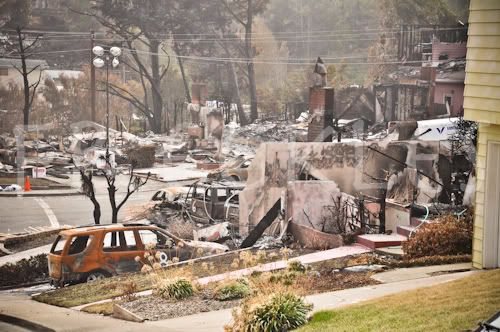










Frisky Feline
Well-Known Member
- Joined
- Jun 2, 2003
- Messages
- 26,316
- Reaction score
- 92
oh my god. thank you freckles for sharing those clearly pictures. 


